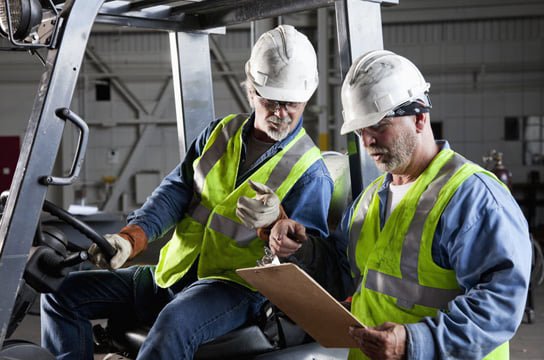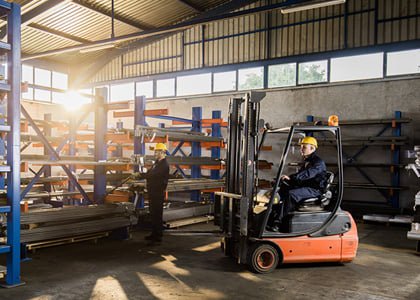Let us help you choose the best equipment to meet your needs!
Do you need a standard forklift or an order picker? What about the fuel type, mast requirements, and attachment options? If you’re not sure or need help deciding what truck is best for your needs, read our comprehensive guide.

Standard Forklift
The standard forklift, also known as a counterbalanced sit-down lift truck, is the vehicle most people think of when they think Lift truck or Forklift. It is available with any of the fuel types and tire types as well as numerous weight capacities, lift heights and attachment options.
The smaller 3000 lb to 4000 lb trucks are the workhorses of most warehouses. If you are running a small operation and will only have one truck, this is probably the vehicle for you. The standard forklift is a wide aisle truck which requires at least 11′ aisles to turn in. The aisle width is determined by the size of the truck, the turn radius, and the size of the load. Available options and attachments include side shifts, fork shifts, hydraulic clamps, and slip sheet attachments, to name a few. The side shift is becoming standard equipment on many trucks. See all standard forklifts in the store.
Reach truck (a.k.a. Stand-up reach, Straddle reach, Double-deep reach)
The reach truck is a narrow aisle (8′-10′) truck designed specifically for racked pallet storage. It consists of outriggers in front and telescoping forks that use a hydraulic scissors-type mechanism that allows you to pick up the load and retract it over the outriggers. This reduces the overall truck and load length, allowing you to turn in a narrower aisle. Double-deep reach trucks use an extended reach mechanism which allows you to store pallets two deep in a specifically designed double-deep rack. Reach trucks are designed for racking areas only and do not work for loading trucks or quickly moving loads over distances. Operator training on reach trucks tends to take longer than on other vehicles due to the complexity of the controls. See all reach trucks in the store.
Motorized pallet truck (a.k.a. Walkie, Walkie-rider, Rider)
Motorized pallet trucks are the motorized version of the pallet jack. They come in “Walkie” versions or “Rider” versions. As you would expect the walkie is designed for the operator to walk along with the truck as they move loads, while the Rider has a small platform which the operator stands on. The riders work great for the frequent moving of loads over extended distances within warehouses and manufacturing operations loads over extended distances within warehouses and manufacturing operations. They are fast and highly maneuverable. Minimal controls result in short learning curves for operators although precision turning takes a little practice. See all motorized pallet trucks in the store.
Order picker
Designed specifically for manual handling of less-than-pallet-load quantities in racking. A man-up design has fixed forks attached which elevate the load and the operator to facilitate manual loading and unloading from racking. Order Selectors are very narrow aisles vehicles which operate in aisles of less than 6′.
Order selectors are available in lift heights up to 40 feet however 20 to 30-foot models are more common.
Fuel Types
Electric. Electric vehicles are designed for indoor use only. Their big advantages are the absence of fumes and their quiet operation. If you only intend to use your vehicles indoors, this is the way to go. In multi-shift operations, you will need additional batteries and charging/transfer stations. In single shift operations, or, if the truck is not used 100% of the time, you can charge it during off hours. Note that the batteries and chargers for lift trucks are usually priced separately from the lift truck itself.
LP Liquid Propane. Advantages of using LP include minimal fumes (however heavy use indoors requires adequate ventilation), the ability to use both indoors and outdoors, and the ability to quickly change LP tanks. Commonly used in indoor/outdoor operations such as lumber yards.
Gasoline or Diesel. Outdoor use only. Heavily used in construction, scrap yards, etc.
Tires
Cushion Tires are solid tires generally with no tread pattern (though tread patterns are available) designed for use indoors on smooth solid surfaces. Pneumatic tires require air and are designed for use outdoors on uneven and loose surfaces.
Pneumatic tire trucks will also have higher ground clearance which raises the center of gravity thus reducing its rated lift capacity.
Mast Options
Single, double, triple and quad (which reflects the number of sections or stages the mast has) are the types of masts available. In many circumstances, you will not need to make a choice here since the lift height will dictate the type of mast you will get, however, in trucks with very high lift heights you may have an option. Going to a quad mast instead of a triple, rated at the same height, will give you a shorter mast in the lowered position, eliminating overhead clearance issues.
Aisle Type
Lift trucks are classified by the types of aisles they are designed to operate in. Wide Aisle and Narrow Aisle trucks are designed to turn in the aisle while Very Narrow Aisle trucks do not turn within the aisle.
Wide Aisle. Standard forklifts fall into this category of trucks designed to work in aisles greater than 11′ wide. Narrow Aisle (NA).
Narrow aisle trucks operate in aisles of 8′ to 10′ and are generally stand up vehicles such as Reach Trucks
Lift Capacity and Height
You will need to know the maximum weight and dimensions of the loads you will be handling as well as the maximum fork height needed to stack or rack the loads in order to determine the capacity of the vehicle needed.
The lift capacity of a truck is affected by lift height and load size. A larger size load moves the center of gravity of the vehicle/load combination reducing the lift capacity as does the height the load is being lifted. Attachments also affect the capacity of a truck.
